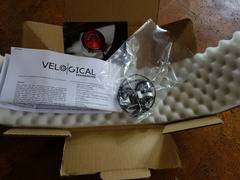
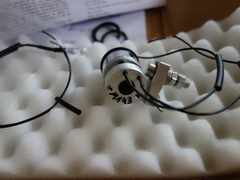
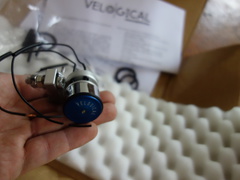
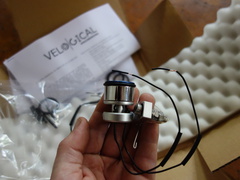
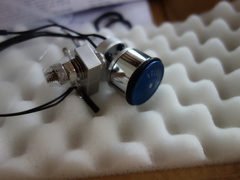
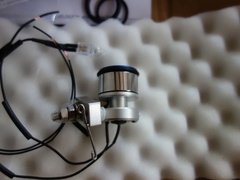
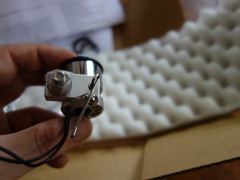
| [ Main index » Bicycle components tests » (Dynamo) bicycle lighting » Dynamos » Velogical rim dynamos | ] |
On the main page I wrote in the section about news from manufacturers:
2013-3-3: I saw the webpage on the velogical rim dynamo long ago (I think mid 2012) but it didn't seem interesting to me because of the problems that all rim- and tyre dynamos have, so I just mention it here as a curiosity: http://www.velogical-engineering.com/rim-dynamo.
and in the section on dynamos that might be of interest:
The velogical rim dynamo is a curiosity. It doesn't seem too interesting to me because of possible problems in the rain, because the rubber needs to be replaced relatively quickly, and because the price is quite high at ca. € 150,-. I read about it I think mid 2012, and seems to become available summer 2013. Power output is lower than other dynamos so it doesn't comply with StVZO's 3W power output requirement at 15 km/h. My experiences with a rim-running Sanyo were not positive (1990s) in the rain, but perhaps it would be suitable as a backup solution for those who don't ride at nights often, and I presume noise won't be an issue contrary to a dynamo that runs on the tyres.
At first there was just one such dynamo, but on 2013-9-19 I revisited the page on these dynamos to create this page with a user report on the only model then made, which was the sport model (I think), and now there are 3. From the site:
Mass: ?
User serviceable: ?
2014-8-2: I have now got the special model (blue, as I want to see how well this model works at low speeds for USB charging) which I will test on various rims and which I will test long term.
First experiences, 2014-8-3: Using with Edelux with Lumiring+Secula taillamps (wired in parallel to the Edelux's output): With the light off, but dynamo rolling on the rim, it makes very little noise, but it can be felt that the dynamo is rolling on the rim from vibrations in the bike. It is a lot better than normal sidewall dynamos, but still a bit annoying. With the light on the noise is a lot stronger, and from ca. 25 km/h it seems to get less noticeable (the dynamo then seems to run more smoothly, and there is more wind noise). Riding in the rain with a fairly new rim (I was using the wheel that I built not so long ago with the PD-8X dynamo hub) it didn't slip so far but I was only cycling in the rain at low speeds, up to ca. 20 km/h. Mounting with the brake stud adapter was a bit tricky on the front wheel as the fork on my main test bike has fairly narrow brake mount points (a Magura HS33 doesn't fit because of this, width is an old standard of 65mm which is not good but it's my main test bike for lighting so I want to keep using this bike for all lighting tests and esp. vibration testing) which means I had to position it very carefully so only the rubber and nothing else of the dynamo touches the rim.
Velogical sent a new adapter for this width, which is excellent. More experiences, esp. in the rain but also noise: The dynamo starts making more noise at around 20-25 km/h, then from 25-30 it's nearly quiet, and at 30km/h a strong whine. This all without the thermistor as I want to see how that works first and to see if I can detect a difference in use with the thermistor in place. In the rain the dynamo makes less noise, or rather I suppose the sound gets dampened. A few times when it started to rain I got the impression of less light, so does it slip? But this was almost certainly caused by the wetness which means less light reflected from the fender back to me and from the road back to me. This is very hard to test except by making the rim wet while riding on a dry day. I will do that to make sure, but I tried riding fast up to ca. 42 km/h in the rain to see if there was any slipping, i.e. light getting stronger and weaker, and there was no such problem. Of course, the dynamo was pressed fairly hard against the rim with the original mount and the narrow 65mm brake stud distance, I will see what happens with the new mounting plate for this width.
Noise: With an Edelux and no thermistor (I will try everything :)) noise is there until about 25 km/h, then from 25-30 km/h it is almost gone, and at 30 km/h a louder whine starts. With a Roxim D6 the noise doesn't decrease as much at around 25-30 km/h but also not a strong whine at 30 km/h. This really shows something about the electronics of the headlamps...
Slipping: It works perfectly without noticeable slipping even when wet, but from the noise decrease one might think that the dynamo is not rotating as fast. However it seems to work with a normal headlamp, so not a special device that extracts more power such as Forumslader (see below the 2nd user report, on slipping in this case), always as it should. I did feel on the transition from dry to wet (when it started to rain during a ride), that lightoutput of the headlamp dropped, but of course this is exactly what happens with rain anyway (less light gets sent back to your eyes, a lot reflects away from road surface because of the water, ditto even for the front fender). And when riding fast (up to more than 40 km/h) in the rain, there was no slipping, at least not a further drop in reflected light from the headlamp, it seemed to stay fine. So for normal headlamps/taillamps I consider slipping a non-issue.
Efficiency: I haven't got the setup to measure the efficiency, yet. But if all goes well then I will test such things in 2016.
The efficiency of the dynamo itself is probably not as high as the Schmidt SON28 or SP 8 and 9 series hubs, and you will also have losses from running on the rim. the losses can really be heard because noise = energy. So perhaps overall efficiency is half that of a hub dynamo?
I tried to feel whether I can feel the loss by cycling at 20 km/h with and without the dynamo and then try to keep power the same with power off and speed increased sometimes, but it's very hard to keep power (from how it feels to pedal at a certain power) constant, so it could be other factors, so sometimes I thought I could feel it, other times not, whereas with dynamo hub it's definitely impossible for me to feel when switching light on/off unless it's from the vibrations (so I can feel the vibrations, but not the speed loss).
I think the speed difference as I felt it, could be real, but it's not that important. What I mean, the speed loss as I mentioned on the bottom of my main lighting page isn't that big anyway, not so big that you notice "wow, I'm being slowed down by the dynamo!", I never had that with any sidewall dynamo, and definitely not with the Velogical.
Some time after my first tests, figures from Olaf Schultz have showed up which show that the efficiency is quite good, not much lower than a high efficiency dynamo hub.
So it's an excellent product, and the only sidewall dynamo that I can recommend as always working (although: Still need to do the slightly untrue rim test and riding in snow, and note that I used the brake mount which will be better than a rubber band as in the first user report...) and being of great quality, but you must keep in mind that it produces noise similar to other sidewall dynamos which can be annoying...
Perhaps I can do the snow test end of December as snow is being forecast for 27 December 2014... [ Update: Almost no snow appeared, perhaps this winter of 2015-2016 I can experience the dynamo in snowy conditions ]
I've used it for over a year now, switching use with a dynamo hub, and it's now mounted on my rear wheel.
Conclusion: The build quality is fantastic, it looks nice, and support is excellent too. The only downside really, is the noise. I didn't experience slipping yet (or at least, it was inconsequential, will only be noticed with high power devices that extract more than the normal bicycle lighting does).
I still need to try it on a wheel which is slightly out of balance.
I think this dynamo is a good one for people who only want a dynamo for emergencies, or for who doesn't want a dynamo hub/new wheel or in cases where a dynamo hub is not an option (some recumbents). This is also an area where the Sunup DS can be used, and both are excellent products. The Sunup makes no noise, but is a lot clunkier, heavier, and my sample as I showed did have a small issue with water after a year or 2 of use in the rain. I can't tell anything about the Velogical yet from that long use. I asked Velogical that I can keep the test dynamo for this purpose, and I will keep using it and update this page over time... At the moment it's a year later, and the dynamo runs as new, is on my testbike which is almost always outside in rain etc...
2015: Addition from Velogical, for people wanting to use 'Forumslader': The electronics of the Forumslader (battery charger) is adjusted to hub dynamos and apparently doesn't work well with the Velogical dynamos, so you need to ask for a version suited for the Velogical dynamo...
http://www.velogical-engineering.com/rim-dynamo
Report based on an email exchange of a bicycle builder with me, about using the Velogical dynamo (original one, which is the 'Sport' it seems) which he allowed to be used for on my website.:
One of his customers agreed to test the new Velogical rim dynamo on a so called "demi-course" in French or "Halbrenner" in German, i.e. a road bike but more comfortable, with wider tyres and and some possibility to take light luggage (see the pictures).
The dynamo seems of high quality, extremely compact and light, low noise, easy to install on the bike.
The instructions for the wiring are to put a 5W bulb in
parallelseries with the headlamp, which is supposed to lower the resistance (and the manufacturer claims the dynamo heats up less then). This gave some problems in the LED headlamp Lyt not working in some cases, it was unclear why, so he disconnected the bulb which made everything work fine.The mounting arm seems surprisingly small and looks fragile but it does the job. Maybe there isn't that much force... The weakness in his opinion is not slipping in wet weather but rather the fact this dynamo must be very close to the rim in the off position (3-5mm) and so the wheels must be very true. Also, if this is not the case then the effect of more/less pressure on the dynamo wheel is immediately visible with the headlight's output varying from weak to strong, with each turn of the wheel..
WHS: this shows that small imperfections in the rim's trueness already make the dynamo slip a bit when it's dry...
All in all he thinks the Velogical dynamo is only suitable to demi-course bicycles that will rarely use lighting and where you don't want to use battery powered lamps.
All dynamos have flickering lights due to imperfect wheels/tires/slipping, but when you pay €150 it's more disappointing. For use in more adverse conditions and/or bikes with wider tires, a Axa HR or B+M Dymotec would be preferable.
WHS: We need to differentiate in flickering coming from the dynamo due to e.g. slipping as with sidewall dynamos, and flickering from the headlamp because of not enough power coming from the dynamo or because of the low pulsed power from dynamo hubs (some headlamps then give a burst of light, get dark again, give a burst again with low power). So the flickering here with the Velogical dynamo can be caused in 2 ways... One as mentioned above, the other caused by the headlamp which tries to give light but the dynamo doesn't provide enough at low speeds (power output of the original velogical dynamo is less than standard StVZO dynamos).
He doesn't have an opinion yet on whether it's really worth the price, but his view was that that depends on whether it's reliable, which is not yet known.
WHS: Sounds logical to me :) Though for me it would not be worth it because of the possibility of slipping already when it's dry, never mind in the rain or with snow! Note that I haven't had a report yet on how well it works in the rain...
I got a comment from Velogical about this report, that the bulb used was actually meant for a dual headlamp setup (5W for dual lamp, 20W for single lamp)... Also that setting the tension with stronger rubber band should be able to take care of slipping. Well, I can only go by the report I got, and I have to go with the report from someone who used it above claims from a manufacturer. I cannot just accept a manufacturer's claim that "this will fix it" as true. If Velogical want to send me dynamo to test then I will see about testing it all myself under all circumstances and whether another rubber band helps, but I will let the comments as above stand (note that I discussed Velogical's response with the bike builder).
2014-7-21: Another report from someone who used the dynamo on the rear wheel of a bike:
I own the trekking model of the dynamo and so maybe I can add some points.
Some remarks about my setup: The dynamo runs on the backwheel of our back to back recumbent bike tandem. Some pics are here:
http://radseiten.die-andersecks.de/tandembau.php
The dynamo is not connected directly to any lighting components but to a Forumslader which is specifically adapted to the characteristics of the dynamo (thanks Jens During for that). The lighting is then done via a Busch & Müller Cyo Premium head lamp for e-bikes which is powered from the Forumslader's 12V buffer and which offers 7V to the rear light, the Philips Lumiring (you remember, we were already in a discussion about its power consumption while charging its capacitor). Apart from that we charge our GPS batteries, the digital camera and our phones from the Forumslader which during the last vacations were the main energy eaters.
One thing about the 5W bulb which is also mentioned in the report on your website: The manual doesn't claim to install the bulb in parallel with the headlamp but in series. Electrically it's totally clear that the headlamp doesn't do anything if the bulb is in parallel as its resistance is very low as long as it is cold. Therefore the current takes the way of the least resistance which doesn't lead through the headlamp When putting the bulb in series under low power it will have almost no resistance but when the dynamo speed increases it starts lighting, its resistance increases, too, and therefore both the dynamo and the lamps are more or less protected against to much current (which would let the dynamo overheat).
WHS: The dynamo was wired correctly I presume. Perhaps the times that it didn't work it was wired parallel... Or perhaps it was because of the wiring being wrong in some cases of because the wiring wasn't fully OK when testing. Whatever it was, it points to one problem with the dynamo when using the bulb, namely that the additional component introduces an added complexity in wiring and in connections.
Jens During, the Forumslader guy has tested the dynamo at high speed and written on the Liegeradforum about that: http://www.velomobilforum.de/forum/index.php?threads/compact-dynamo-am- federbein.38819/#post-567470
Back to my setup and my experiences: During our last vacations we had the dynamo running for more than 1000km. Its sound is of course noticable but acceptable. At around 30-40kph the wind around the ears becomes dominant and the dynamo cannot be heard anymore. When cycling with lights on the Forumslader shows a negative balance in its buffer when going at lower speeds but a positive balance when going faster (~30kph and more). This shows that with all the energy conversion losses the dynamo is well suitable for average bicycle lights. As mentioned earlier during vacation it was able to charge GPS, camera and phones faster than we discharged them while using them (okay, we had a look at not wasting too much energy, but we used them all). We never had any problems with slip when it was dry. But when it was wet it was only a small step to the dynamo not spinning at the correct speed anymore. It still runs but only slowly. According to the remaining sound it follows the bike's speed up to about 15kph and then remains there (of course depending on how wet it is) even if the bike accelerates further.
WHS: This is typical for any rim or tyre driven dynamo. I've experienced it with lots of them...
According to Velogical this behaviour also depends on the type of rim, its surface etc., but I cleaned our Remerx Super Jumbo from all grease and oil before. Maybe with rim brakes it is possible to "dry" the rim a little bit but with our disk brakes it isn't.
WHS: I don't think drying works, certainly not from wiping the water off the rim, it will always stay wet in my experience. If you brake so much that the rim gets warm/hot such as in a descent, then still I don't see it evaporating water on the rim quickly enough.
On a conventional bike I'd use the dynamo on the front wheel as the rear wheel will most likely be sprayed by the front wheel. On our tandem the distance is too big for the front wheel to really spray the rear wheel Funnily enough the wetness problems usually begin earlier when the wind comes from the left side where the dynamo is mounted. So it's really the rain itself that is blown onto the rim...
For our lighting I'm quite happy to have the Forumslader between dynamo and lamps as with its buffer it can bridge the power gap for quite some time when it is wet.
Conclusion: In my opinion it is the best solution you can have if a hub dynamo is not possible. It seems to be long lasting, has better bearings than conventional sidewall dynamos, runs more smoothly. Its electrical specs are somewhat unconventional which you should know and use the bulb correctly. But especially for a bike which has to run regularly under all conditions I would still do everything to make a hub dynamo possible. True wheels are a condition of course, but well, that's also a condition for a well running bike which is what we all want :-)
| To email me go to the email page |
Last modified: 5 Aug 2014